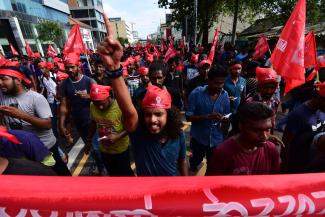Private education
“Fierce competition”

Why have so many private colleges and universities been set up in South Asia in recent years?
- This trend has more than one cause, and it affects education in general, not only the institutions of higher learning. Important aspects include:
- In our world region, education is valued highly. Most parents, therefore, give priority to the education of their children and are prepared to make the necessary sacrifices.
- During the long colonial period, Protestant and Catholic churches established schools according to the models prevalent in the imperialist countries. They levied fees and served the elite sections of society, but were not profit-driven. In British colonies and affiliated princely states, they produced English-speaking graduates who could be absorbed into the colonial administration. By the time of independence, these schools were well established and highly regarded. These schools – some of which are now supported by the state – adapted to the changed conditions after independence and are now an integral part of the education system.
- In Sri Lanka, “free education for all” was introduced in the early 1950s for primary, secondary and tertiary education up to the bachelor’s degree. As a result, all children attend at least primary school, and Sri Lanka’s basic literacy and numeracy rates approach 100 %. After all these years, free education is considered a basic right and, therefore, politically extremely sensitive.
- Since the 1960s or so, the number of state schools has nonetheless fallen short due to increases in both population and demand. Therefore, we have seen a rapid growth of private schools in recent decades. The situation is similar in other countries in our world region.
- South Asian governments do not expend the resources needed to improve all educational state institutions resulting in a hierarchy in the quality of schools. In Sri Lanka, the government conducts a national examination around grade 5 level (age 10), and the best students are given admission to one of the elite schools which have all the facilities. This procedure has several negative consequences: it drains the best students from the provinces and villages, thwarts the development of village schools and leads to a great deal of heartburn among parents who cannot gain admission to “good” state schools. This is the primary reason for the recent increase in the demand for private schools.
- Although the number of government-run Sri Lankan universities has increased to around 25, the total number of places available is far from adequate. Less than 20 % of the students who are, in theory, qualified to attend them can be admitted. Accordingly, competition is fierce at the national advanced level examination (level 13). Again, the scenario is not much different in India, Bangladesh and Pakistan. In India, the government decided to allow twice as many students into government-run universities, but did not appoint additional professors or expand teaching facilities accordingly.
- The private sector, seeing the situation of need with so many young people wanting to get higher degrees as a business opportunity, stepped in, resulting in a large number and broad range of fee-levying tertiary institutions. Most of them are profit-driven and include public-private partnerships. Some are affiliated to universities in western countries.
An increasing proportion of pupils of primary and secondary school levels attend private schools. The share of South Asia’s tertiary students who attend private-sector colleges is even larger and growing fast. Private colleges are better able to adjust to changing skills demand in the labour market and mostly focus on employment-oriented business-school programmes with subjects such as business management, human resource development, public relations, hotel management et cetera. By contrast, the state universities are more academic and conduct research.
Are all institutions of reliable quality, and who assesses that?
This is a sensitive issue with several dimensions:
- For political reasons, all Sri Lankan governments have maintained the myth of “free education for all”, officially ignoring private institutions that have recently been established. Accordingly, we do not even have the legal framework for a proper regulatory mechanism.
- State schools at the secondary level and those established during colonial times have systems of inspection and quality assurance. These schools train students for two national examinations – at level 11 and level 13 – and need to meet the respective standards. Due to the intense competition for the A level examination, most students follow additional classes in tutorials, so that has become a thriving private industry.
- At the undergraduate level, standards and systems of quality assurance have been introduced in state universities over the past two decades. They are now quite well established. There is no regulatory process, however, for postgraduate programmes. One consequence is that tuition varies widely. A semester in pursuit of an MBA (Master of Business Administration), for example, will cost anything from the equivalent of € 500 to € 4,500.
- Legislators have been considering a new law to regulate higher learning for more than a decade, but the legal framework for accreditation of degrees – both undergraduate and postgraduate – is not yet in place.
Are there new centres of excellence that are equals of the best government-run institutions or perhaps even superior?
Generally speaking, private universities are no match for Sri Lanka’s state universities due to the lack of staff and facilities. As I said, they are mostly business schools and teach a rather narrow range of subjects. It is noteworthy, however, that a handful of private, elite-oriented secondary schools has recently emerged. They prepare students for overseas examinations, so their graduates have the London GCE (general certificate of education) or the International Baccalaureate and are thus officially entitled to study at British and Swiss universities respectively. These exams are accepted in many countries. The schools concerned cater to the better-off and teach almost entirely in English. They use up-to-date methods such as outcome-based education (OBE) and learner-centred teaching (LCT) which have not been introduced to the local state schools.
Does the trend towards private education reinforce the privileges of the wealthy few?
The establishment of state universities in the late 1940s allowed previously marginalised people to become upwardly mobile. In the 1960s, entry into university did not depend on merit alone, but was also based on the area of origin – a form of positive discrimination to underprivileged areas. Children from villages could aspire to obtain university degrees and reach the highest levels in the public service. By contrast, I think that the more recent trend of greater privatisation of education at all levels mostly benefits the more affluent.
Is there a gender angle, with families more willing to invest in the education of sons, for example?
Although there may be some differences between the four communities – Buddhist, Hindu, Christian and Muslim – I think most parents are happy to spend on their daughters as well. In fact, due perhaps to their studiousness, the proportion of girls entering universities is generally higher than that of boys. That is even so in Sri Lanka’s Muslim community with girls being encouraged to study and work. This is now spilling over to the workplace with more female than male workers in many sectors.
If educational institutions are simply profit-driven businesses, some of them are likely to fail. What happens to students, who make considerable investments, if their school goes bankrupt – or if their degrees turn out to be substandard and are not accepted internationally?
This has already occurred with parents and students left “high and dry”. A common marketing strategy is to promise that a private institution’s degree is equivalent to that of a foreign partner institution, but that is not always true. Students became very angry when they discovered that their studies were not worth what they had been told. So far, all Sri Lankan governments have abrogated their responsibility to those students and their parents. There is little doubt that Sri Lanka must regulate private universities properly. That must be guided by a sound policy and done in a transparent manner.
I have been told in Bangladesh that the government is keen on students getting degrees from private universities, hoping that they will be able to migrate to high-income countries and send home money. Is there a hidden agenda of promoting migration through private education?
If so, at least that is a policy which seems to have borne fruit. Bangladesh has a healthy balance of payments due to remittances from those who work abroad. In Sri Lanka, the lack of opportunities for private higher education drives parents to spend a lot of money so their children can study in foreign countries.
Sivali Ranawana is professor emeritus in nutrition at Wayamba University of Sri Lanka and has been an evaluator of higher education in Sri Lanka and Bangladesh for more than ten years. In his most recent assignment last year, he co-authored a study of post-graduate education for the National Education Commission in Sri Lanka.
sivalir@gmail.com













